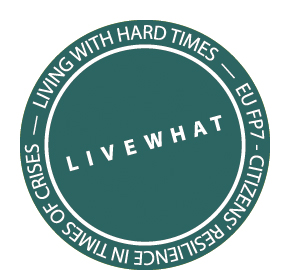Activities
 The LIVEWHAT project consists of 10 workpackages (WPs)
of different size, importance, and duration: 6 are devoted to research
activities, 3 to dissemination, and 1 to management.
The LIVEWHAT project consists of 10 workpackages (WPs)
of different size, importance, and duration: 6 are devoted to research
activities, 3 to dissemination, and 1 to management.
Research activities Research activities are based on distinctive objectives and types of data. The first activity aims to defining, identifying, and measuring crises through social, economic, and political indicators (WP1). The second activity aims to analyze the ways in which crises are dealt with in the policy domain through the analysis of policy documents and interviews with key informants (WP2). The third activity aims to describe and analyze collective responses to crises by both policy actors and citizens in the public domain, in the form of political claims-making (including collective mobilizations and protest events), through a systematic content analysis of newspapers over time (WP3). The fourth activity aims to describe and analyze individual responses to crises by citizens, in the form of individual attitudes and behaviors, through a population survey (WP4). The fifth activity aims to study the causal mechanisms linking situations of economic crisis and their consequences on citizens through a series of experiments (WP5). The sixth activity aims to study alternative forms of resilience in times of crisis, through a two-step procedure aimed at mapping existing grassroots and community initiatives as well as to analyzing role of these actors and initiatives and their impact on changing lifestyles, consumption patterns, and creative forms of resilience (WP6). Overall, two kinds of data will be gathered: observational and experimental data. Observational data – especially those collected in WP4 – will identify potential causal relationships. WP5 will then test such relationship through experimental data. This will be done on the basis of existing hypotheses as well as on the basis of potential causal hypotheses emerging during the research process.
Dissemination activities are divided into policy, public, and scientific dissemination. Again, this should help implementing these tasks more effectively. Policy dissemination (WP7) is targeted at policy-makers as well as at the main stakeholders and practitioners (e.g. professional organizations, trade unions, consumers’ associations, unemployed organizations, charity groups), and aims to transfer knowledge for policy and practical usage. Public dissemination (WP8) is targeted at the general public and aims to translate the research finding into a language accessible to non-specialists so as to sensitize the public opinion towards the issue of citizens’ resilience to crises. Scientific dissemination (WP9) is targeted at scholars working on the topic of the research and in related fields as well as students and, more broadly, the scientific community and aims to improve scholarly work on citizens’ resilience in times of crises.
Management tasks are broken down into two main components: scientific and administrative tasks. Scientific and administrative management will be carried out by different offices. Scientific management will be conducted by the project Coordinator, with the support of the project’s Management Committee, while the administrative management will be the main responsibility of the administration of the coordinating institution (UNIGE). These two entities will constantly liaise for the implementation of the management tasks.
